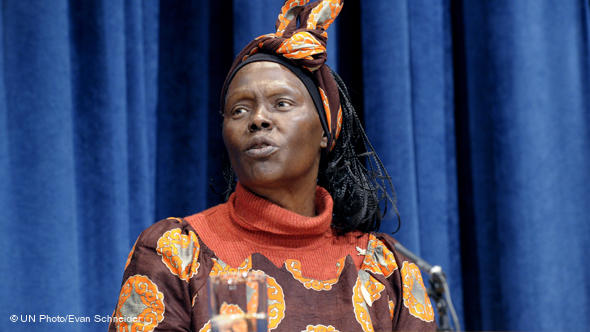Search Results for Tag: Africa
Are drones the next weapon against poaching?
In 2013 South Africa lost more than 1000 rhinos to illegal hunting. In other countries such as Vietnam, rhinos are already extinct. Now, a US company hopes to launch unmanned drones equipped with cameras to frighten off poachers.
Airware is a company that develops a new autopilot system for commercial drones. Those drones can be used for many different purposes, the company says. Such as inspections, search and rescue operations – or to watch out for poachers across large areas of African safari parks.
The company has conducted a field test in Kenya with drones designed to protect rhinos. First results suggest they may be a promising tool for wildlife conservation.
But why in Kenia? The country lost 50 rhinos in 2013. The team went to Ol Pejeta which is East Africa’s largest black rhino sanctuary. Set up to act as a deterrent and for surveillance the drone was sending real-time video and thermal imaging feeds to the rangers on the ground. The drone navigates autonomously, along a prescribed flight route and requires just one person to operate, who can also instruct the aircraft what to look out for with the on-board camera.
The test prototype “surpassed all our expectations,” the team said afterwards. Just maybe tech innovations like these could help to preserve threatened species.
And it is an effort, that is obviously more realistic than a concept by artist Robert Chew. He thought about robots that take the forms of (poached) animals to blend in with the wildlife and help capture poachers.
A comprehensive inventory of Tanzania’s forests
Nearly 20% of green house gas emissions worldwide are caused by deforestation and forest degradation in developing countries. Estimating and reducing these emissions is therefore one of the key goals for the international community as the Rio+20 conference on sustainable development in June draws closer. One country attempting to do just that is Tanzania. The country is currently in the process of drawing up a comprehensive inventory of its forests as you can see in the video above by the Food and Agriculture Organization of the United Nations (FAO). The inventory is meant to help the East African country to better manage its natural resources. Today more than a third of Tanzania is forested, but almost 1% of that forest is being lost annually. The inventory will measure how much carbon is stored within Tanzania’s forests and will help the country to understand the role it can play in mitigating climate change.
French
Spanish
Fighting climate change together
 It takes a village, goes the saying – and in fighting climate change, many environmentalists say it will take the world. A group of Southern African countries are teaming up to better respond to the challenges of climate change by combining climate studies across the entire region. Angola, Botswana, Namibia, South Africa and Zambia have all agreed to be part of “SASSCAL,” or the Southern African Science Service Centre for Climate Change and Adaptive Land Management. The project is being funded by Germany.
It takes a village, goes the saying – and in fighting climate change, many environmentalists say it will take the world. A group of Southern African countries are teaming up to better respond to the challenges of climate change by combining climate studies across the entire region. Angola, Botswana, Namibia, South Africa and Zambia have all agreed to be part of “SASSCAL,” or the Southern African Science Service Centre for Climate Change and Adaptive Land Management. The project is being funded by Germany.
Because climate change is affecting so many millions of people across Africa, SASSCAL countries want to figure out ways to adapt, to manage the wealth of natural resources in the region. to institute sustainable land management and improve living conditions. That’s no easy job, but with research institutes from every participating country working together to study climate change and its impact on resources, the organizers believe a lot can be achieved. And, it sets an important example for the rest of the continent and the world…
Chocolate No More?

The International Center for Tropical Agriculture just released a report that shows that the cocoa supply in West Africa is under threat. As our climate gets warmer and warmer, the soil heats up, and the normal patterns of rainfall are also changing quickly. Why is that important? Because Ghana and Côte d’Ivoire are home to half of the world’s cocoa supply.
According to the International Center for Tropical Agriculture, which is based in Cali, Colombia, by the year 2050 the amount of land that’s now used for cocoa production will be drastically reduced, and instead moved to different plots of land that don’t offer suitable growing conditions. And since the demand for chocolate is on the rise but production is falling, we’ll probably end up paying a lot more for the sweet treat.
The study’s authors recommend finding cocoa plant varieties that are heat-resistant and can adapt to changing climate conditions.
In memory of Wangari Maathai
She was the first woman who got the Nobel Peace Prizein 2004 for her campaigns to save Kenyan forests. Kenyan environmentalist, Wangari Maathai, died on September 25th while undergoing treatment for cancer at a hospital in Nairobi. She worked over the last decades to plant over 20 million trees throughout Africa. She always had to battle with the government of her country. She was imprisoned and brutalised, but she won.
In 1977 Wangari Maathai founded the Green Belt Movement. The organisation will outlast her. “You cannot protect the environment unless you empower people, you inform them, and you help them understand that these resources are their own, that they must protect them,” she said and she was definitly right.
Here you’ll find a video (“I will be a hummingbird”) that is worth watching to get a sense of Wangari Maathai.
At the organisations homepage you can share your condolences.










Feedback